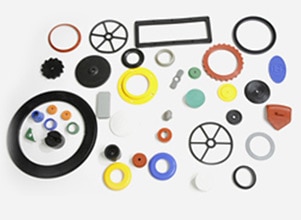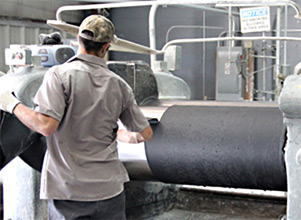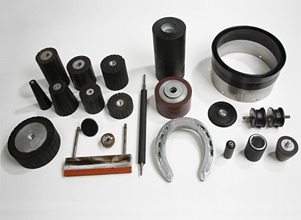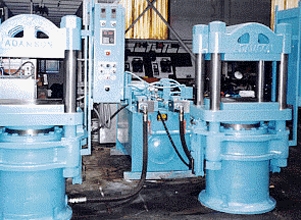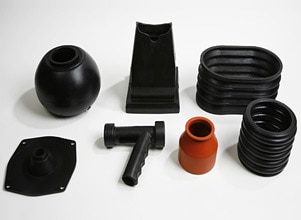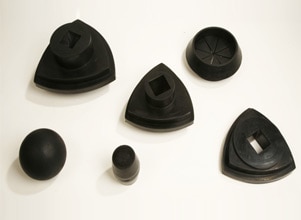Molding Services
Ames Rubber Manufacturing has been molding rubber since 1954 and has extensive experience in compression, transfer & injection molding. We can utilize existing tooling for currently manufactured parts, or assist you with newly designed parts to help determine the most cost effective solution to your molded rubber applications.
We utilize Association of Rubber Products Manufacturers (ARPM), formerly Rubber Manufacturer’s Association (RMA) tolerances for all of our manufacturing processes unless otherwise stated. This ensures that our customers will receive parts that are produced to the rubber industry standard, whether it is non-critical, commercial, precision, or high precision.
Compounding and Stock Preparation
In House Custom Mill Mixing
Rubber isn’t just a generic, black, elastic material. Rubber is vital to the operations of countless companies and fully integrated into thousands of products and devices worldwide. We can formulate custom compounds designed to deliver specialized performance to meet or exceed your unique requirements that no off-the-shelf product can match. At Ames Rubber Manufacturing, we have custom mill mixing capabilities and an active library of hundreds of in house compounds for oil resistant, non-oil resistant and specialty elastomers ranging from Neoprene® to Nitrile and Silicone to Viton®.
A Network of Custom Compounders
Beyond that, we have also developed a network of specialized rubber compounders that we utilize each with experienced rubber chemists representing vast knowledge in virtually every elastomeric specialty to ensure that your rubber molding needs are met or exceeded.
Molding Capabilities
Use our Ames Rubber Molding Guide to help you determine the best molding process for your specific application, or just contact us at your convenience and we will work with you throughout the production process, from concept to completion. Our molding capabilities include:
- Custom Rubber Compounding
- Custom Rubber Prep
- Rubber Compression Molding
- Rubber Transfer Molding
- Rubber Injection Molding
- Liquid Silicone Injection Molding (LIM)
- Insert Molding
- Vulcanized Rubber to Metal Bonding
- Large Part Molding – Our hydraulic molding press capacity ranges from 12” x 12” platens up to 45” x 45” platens.
- Thermoplastic Injection Molding (TPR)
- Prototype and Production Runs
- Rollers – New & Recovered
- Cryogenic De-flashing
- Rubber to Substrate Bonding
- CAD/CAM Mold Design
- In-house Mold Making
- Colored Compounds
- Local Responsiveness – We perform molding services at both our Southern California and Southeastern Tennessee Manufacturing Facilities.
De-flashing & Trimming
Once a rubber part has been molded, in most cases it must be de-flashed.
Ames Rubber Manufacturing has invested regularly in the equipment and technology related to insuring a clean, finished part for our customers.
Cryogenic De-flashing
The most versatile and effective way to de-flash rubber products is through liquid nitrogen tumbling and shot blasting. The rubber parts are placed inside a barrel or basket and liquid nitrogen is used to chill the parts so that the flash becomes brittle, but the part does not crack. Once chilled, the machines tumble the parts around on themselves and fire ceramic media at the parts to encourage all the flash to break off. Depending on the material being run, we can set temperature controls and size and velocity of the media to ensure optimal de-flash with minimal breakage. These setting are saved for each and every molded part that we run.
Mechanical and Hand Trim
In addition to the automated de-flashing equipment, Ames Rubber Manufacturing utilizes specialty grinding and Dremel® tools and other hand tools for parts that would not optimally be cryogenically de-flashed such as rubber to metal parts, and large parts or parts with heavy flash from older molds. With limited employee turnover, our trim and finishing department employees are some of the most experienced and well trained in the industry.
Documentation for Quality Assurance
Once quality acceptance standards are established for a particular part, Ames Rubber Manufacturing uses digital photography to document what is acceptable and what is not. By using prints and pictures with notations with our production travelers, we insure uniform acceptance criteria across shifts and personnel as well as repeatability from year to year.
Solutions by Industry
- Aerospace
- Agriculture
- Apparel
- Appliance
- Automotive
- Chemical Processing
- Construction
- Communications
- Electronics
- Filtration
- Fluid Power
- Food & Beverage
- Furniture
- General Industry
- Heating & A/C
- Hydraulics
- Lawn & Garden
- Leisure Products
- Marine
- Military
- Mining
- Oil & Gas
- Packaging & Sealing
- Pneumatics
- Power Transmission
- Pool & Spa
- Printing & Media
- Recreation
- Robotics
- Sport & Fitness
- Recreational and Sport Vehicles
- Rail Transit
- Vehicles & Engines
Solutions by Item
- Balls
- Baffles
- Bellows
- Bladders
- Boots
- Bumpers
- Bushings
- Caps
- Dampeners
- Diaphragms
- Feet
- Gaskets
- Grommets
- Hoses
- Insulators
- Isolators
- Membranes
- Mounts
- O-Rings
- Pads
- Plugs
- Protectors
- Rollers
- Rubber Springs
- Seals
- Straps
- Toys
- Tubes
- Washers
- Wheels
Materials
These standard elastomers are compounded for most molding applications. Let Ames Rubber Manufacturing work with you to select the appropriate material for your commercial or specification grade elastomeric requirements.
Quick Materials Reference Guide

